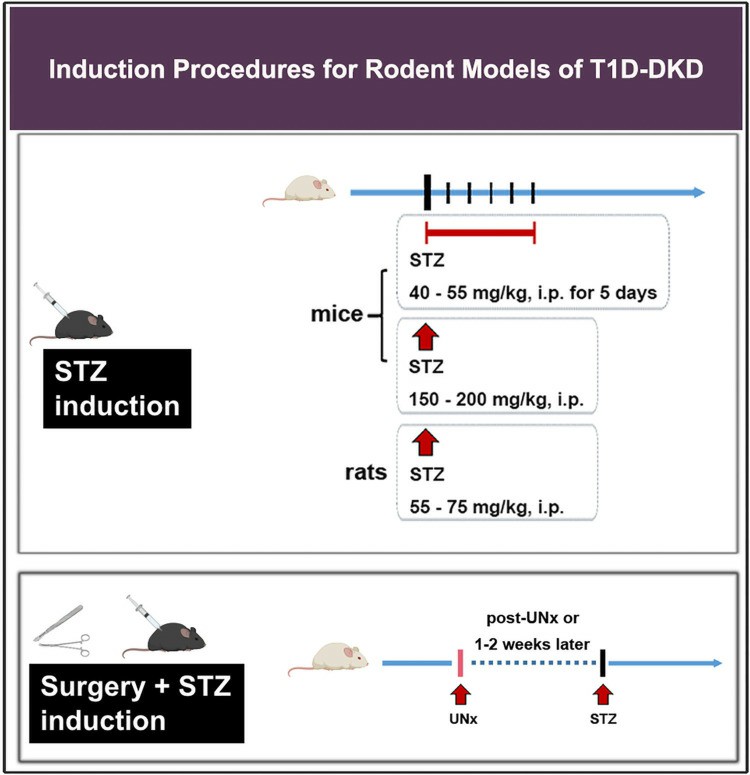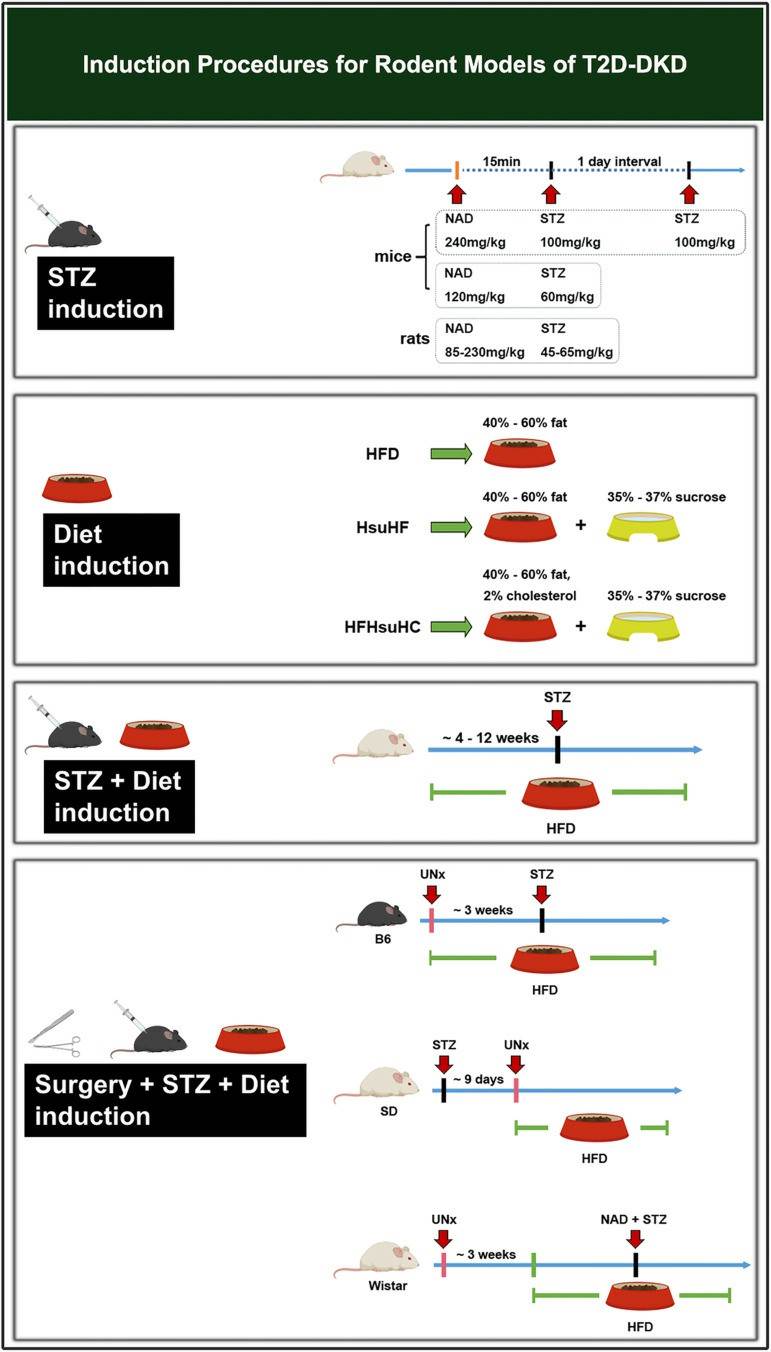Animal Models of Diabetic Kidney Disease
Diabetes, Metabolic Syndrome, and Obesity. 2023 May 5; 16: 1297-1321.
Authors: Luo W, Tang S, Xiao X, Luo S, Yang Z, Huang W, Tang S.
INTRODUCTION
- Diabetic kidney disease (DKD) is a common microvascular complication of diabetes mellitus (DM) that is clinically characterized by a gradual decline in renal function, with or without proteinuria, due to prolonged hyperglycemia. There are no substantial differences between patients with type 1 DM (T1D) and those with type 2 DM (T2D) in the basic pathophysiological mechanisms leading to nephropathy.
- The etiology and pathogenesis of DKD are complex and not well understood, which is a major obstacle to developing clinical control methods. Suitable animal models can provide a basis for clinical treatment and important clues for studying the etiology, pathogenesis, and pathophysiological changes.
Animal Models of T1D-DKD
- Streptozotocin (STZ) induced animal models of T1D-DKD
Using chemical agents-STZ or Alloxan is one of the most popular means to establish animal models of DKD. Compared to Alloxan, STZ is used more frequently in the laboratory because of its higher potency, less tissue toxicity, and stronger model stability. Pancreatic β-cells of rats and mice are more sensitive to the cytotoxicity of STZ than those of rabbits, dogs, and pigs. Besides, the short generation time and low breeding cost make rodents the most commonly used in STZ-induced DKD experiments. - Uninephrectomy (UNx)+STZ induced animal models of T1D-DKD
In general, UNx+STZ-induced models take a shorter time to develop more severe kidney disease than those controls with STZ-induced alone. Different from STZ which gradually develops renal ultrafiltration by inducing hyperglycemia, UNx directly alters renal hemodynamics causing an increase in GFR in the residual kidney. Excessive activation of the renin-angiotensin system (RAS) after UNx can increase blood pressure, as well as the production of pro-fibroblastic cytokines and ROS, all of which contribute to progressive kidney injury and accelerate the development of nephropathy.

Fig. 1 Induction procedures for rodent models of T1D-DKD.
Animal Models of T2D-DKD
- STZ-induced animal models of T2D-DKD
To induce T2D-DKD, STZ is often used in combination with nicotinamide (NAD), a derivative of vitamin B3, whose powerful antioxidant capacity protects β-cells partially against the toxic damage from STZ and keeps animals from developing absolute insulin deficiency. Both rat and mouse models with NAD+STZ induction develop moderate levels of hyperglycemia and albuminuria. DKD symptoms typically appear after 30-45 days, for example, mild mesangial expansion, stromal hyperplasia, and fibrosis. - Diet-induced animal models of T2D-DKD
Obesity induces cellular stress and metabolic syndrome that includes insulin resistance, glucose intolerance, dyslipidemia, and hypertension. Diet-induced models replicate unhealthy dietary patterns in humans, making it close to the pathogenesis of T2D-DKD. Among rodents, B6 mice are more responsive to HFD. Male HFD-fed (≥12 weeks) B6 mice demonstrate metabolic disorders like obesity, hyperglycemia, hyperinsulinemia, and dyslipidemia, and develop early nephrotic manifestations such as proteinuria, glomerular hypertrophy, mesangial expansion, thickening of GBM dominated by increased fibronectin and collagen, tubular dilatation and vacuolization, renal lipid deposition, and inflammatory infiltration. - STZ+HFD-induced animal models of T2D-DKD
The addition of STZ to dietary intervention to reduce β-cell mass can further mimic the features as well as accelerate the progression of kidney disease. Insulin resistance and β-cell dysfunction are two major features of T2D-DKD. HFD induces metabolic disorders, while STZ reduces β-cell mass, ultimately leading to T2D-DKD in animals. - UNx+STZ+HFD induced animal models of T2D-DKD
The mechanism of UNx, STZ, and HFD-inducing DKD was described previously. There is no uniformity in the induction sequence and specific contents of these three, where a high-fat diet can be used either throughout the experimental cycle or after UNx and/or STZ to induce metabolic disorders and insulin resistance.

Fig. 2 Induction procedures for rodent models of T2D-DKD.
Creative Bioarray Relevant Recommendations
Creative Bioarray specializes in providing customized pharmacodynamic research services to help customers assess the efficacy of drug candidates and study the associated pathological mechanisms through T1DM and T2DM models.
| Service Types | Details |
| Type 1 Diabetes Mellitus Model |
|
| Type 2 Diabetes Mellitus Model |
|
RELATED PRODUCTS & SERVICES
Reference
- Luo W, et al. (2023). "Translation Animal Models of Diabetic Kidney Disease: Biochemical and Histological Phenotypes, Advantages and Limitations." Diabetes Metab Syndr Obes. 16, 1297-1321.
